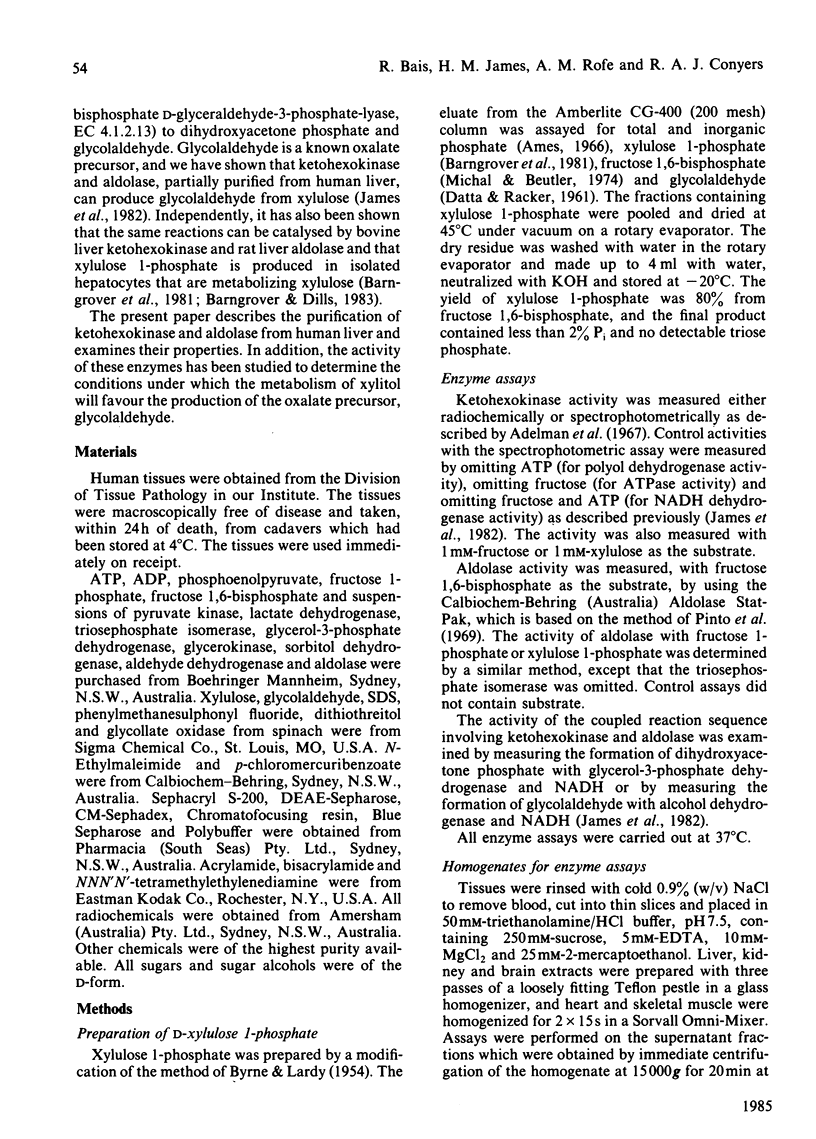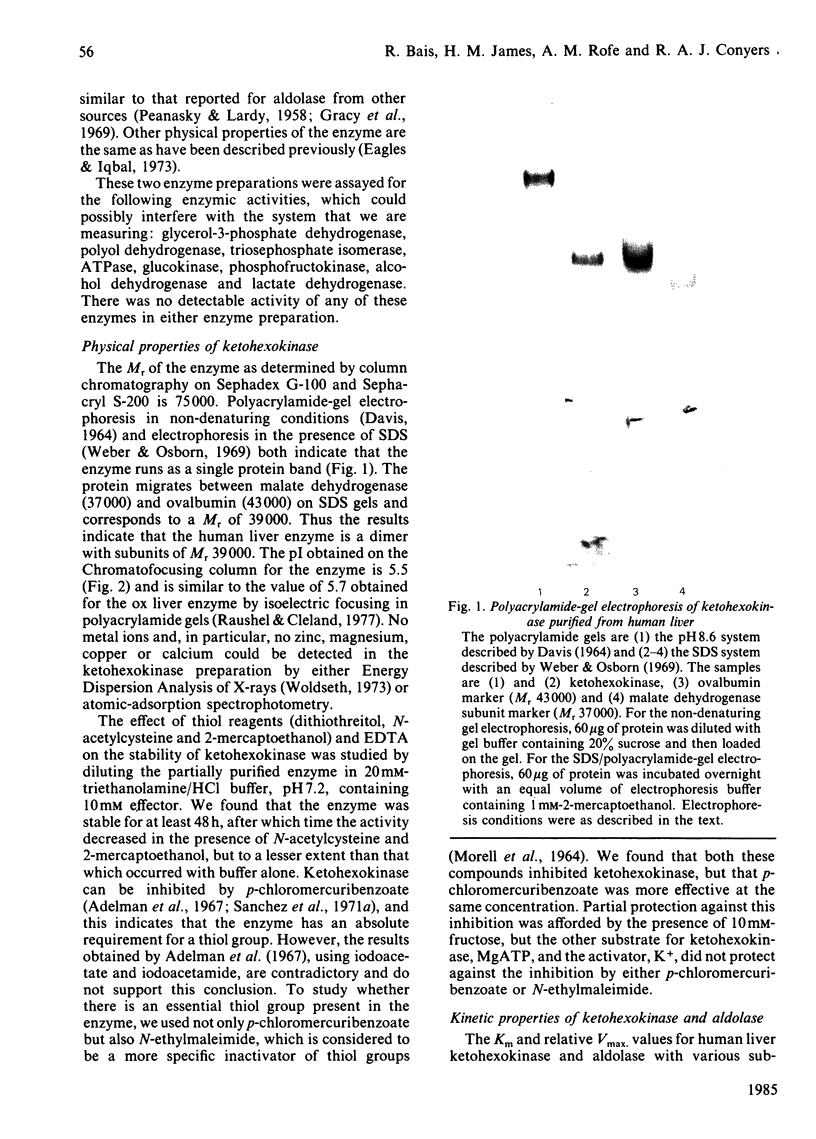Abstract
Ketohexokinase (EC 2.7.1.3) was purified to homogeneity from human liver, and fructose-bisphosphate aldolase (EC 4.1.2.13) was partially purified from the same source. Ketohexokinase was shown, by column chromatography and polyacrylamide-gel electrophoresis, to be a dimer of Mr 75000. Inhibition studies with p-chloromercuribenzoate and N-ethylmaleimide indicate that ketohexokinase contains thiol groups, which are required for full activity. With D-xylulose as substrate, ketohexokinase and aldolase can catalyse a reaction sequence which forms glycolaldehyde, a known precursor of oxalate. The distribution of both enzymes in human tissues indicates that this reaction sequence occurs mainly in the liver, to a lesser extent in the kidney, and very little in heart, brain and muscle. The kinetic properties of ketohexokinase show that this enzyme can phosphorylate D-xylulose as readily as D-fructose, except that higher concentrations of D-xylulose are required. The kinetic properties of aldolase show that the enzyme has a higher affinity for D-xylulose 1-phosphate than for D-fructose 1-phosphate. These findings support a role for ketohexokinase and aldolase in the formation of glycolaldehyde. The effect of various metabolites on the activity of the two enzymes was tested to determine the conditions that favour the formation of glycolaldehyde from xylitol. The results indicate that few of these metabolites affect the activity of ketohexokinase, but that aldolase can be inhibited by several phosphorylated compounds. This work suggests that, although the formation of oxalate from xylitol is normally a minor pathway, under certain conditions of increased xylitol metabolism oxalate production can become significant and may result in oxalosis.
Full text
PDF







Images in this article
Selected References
These references are in PubMed. This may not be the complete list of references from this article.
- Adelman R. C., Ballard F. J., Weinhouse S. Purification and properties of rat liver fructokinase. J Biol Chem. 1967 Jul 25;242(14):3360–3365. [PubMed] [Google Scholar]
- Arsenis C., Touster O. Nicotinamide adenine dinucleotide phosphate-linked xylitol dehydrogenase in guinea pig liver cytosol. J Biol Chem. 1969 Jul 25;244(14):3895–3899. [PubMed] [Google Scholar]
- BYRNE W. L., LARDY H. A. Pentose phosphates formed by muscle aldolase. Biochim Biophys Acta. 1954 Aug;14(4):495–501. doi: 10.1016/0006-3002(54)90229-2. [DOI] [PubMed] [Google Scholar]
- Barngrover D. A., Dills W. L., Jr The involvement of liver fructokinase in the metabolism of D-xylulose and xylitol in isolated rat hepatocytes. J Nutr. 1983 Mar;113(3):522–530. doi: 10.1093/jn/113.3.522. [DOI] [PubMed] [Google Scholar]
- Barngrover D. A., Stevens H. C., Dills W. L., Jr D-Xylulose-1-phosphate: enzymatic assay and production in isolated rat hepatocytes. Biochem Biophys Res Commun. 1981 Sep 16;102(1):75–80. doi: 10.1016/0006-291x(81)91490-x. [DOI] [PubMed] [Google Scholar]
- Bleakley P. A., Arora K. K., Williams J. F. Evidence that aldolase and D-arabinose 5-phosphate are components of pentose pathway reactions in liver in vitro. Biochem Int. 1984 Apr;8(4):491–500. [PubMed] [Google Scholar]
- DAVIS B. J. DISC ELECTROPHORESIS. II. METHOD AND APPLICATION TO HUMAN SERUM PROTEINS. Ann N Y Acad Sci. 1964 Dec 28;121:404–427. doi: 10.1111/j.1749-6632.1964.tb14213.x. [DOI] [PubMed] [Google Scholar]
- Eagles P. A., Iqbal M. A comparative study of aldolase from human muscle and liver. Biochem J. 1973 Jul;133(3):429–439. doi: 10.1042/bj1330429. [DOI] [PMC free article] [PubMed] [Google Scholar]
- García-Carmona F., García-Cánovas F., Lozano J. A. Optimizing enzyme assays with one or two coupling enzymes. Anal Biochem. 1981 May 15;113(2):286–291. doi: 10.1016/0003-2697(81)90079-8. [DOI] [PubMed] [Google Scholar]
- Gracy R. W., Lacko A. G., Horecker B. L. Subunit structure and chemical properties of rabbit liver aldolase. J Biol Chem. 1969 Jul 25;244(14):3913–3919. [PubMed] [Google Scholar]
- Gürtler B., Bally C., Leuthardt F. Reindarstellung und Eigenschaften der menschlichen Leberaldolase. 19. Uber Aldolasen. Hoppe Seylers Z Physiol Chem. 1971 Oct;352(10):1455–1462. [PubMed] [Google Scholar]
- HOLLMANN S., TOUSTER O. The L-xylulose-xylitol enzyme and other polyol dehydrogenases of guinea pig liver mitochondria. J Biol Chem. 1957 Mar;225(1):87–102. [PubMed] [Google Scholar]
- Hannett B., Thomas D. W., Chalmers A. H., Rofe A. M., Edwards J. B., Edwards R. G. Formation of oxalate in pyridoxine or thiamin deficient rats during intravenous xylitol infusions. J Nutr. 1977 Mar;107(3):458–465. doi: 10.1093/jn/107.3.458. [DOI] [PubMed] [Google Scholar]
- Hauschildt S., Brand K. [14C]oxalate formation from [U-14C]glucose and [U-14C]xylitol in rat liver homogenate. Biochem Med. 1979 Feb;21(1):55–61. doi: 10.1016/0006-2944(79)90055-3. [DOI] [PubMed] [Google Scholar]
- Heinz F., Lamprecht W., Kirsch J. Enzymes of fructose metabolism in human liver. J Clin Invest. 1968 Aug;47(8):1826–1832. doi: 10.1172/JCI105872. [DOI] [PMC free article] [PubMed] [Google Scholar]
- James H. M., Bais R., Edwards J. B., Rofe A. M., Conyers A. J. Models for the metabolic production of oxalate from xylitol in humans: a role for fructokinase and aldolase. Aust J Exp Biol Med Sci. 1982 Feb;60(Pt 1):117–122. doi: 10.1038/icb.1982.11. [DOI] [PubMed] [Google Scholar]
- LOWRY O. H., ROSEBROUGH N. J., FARR A. L., RANDALL R. J. Protein measurement with the Folin phenol reagent. J Biol Chem. 1951 Nov;193(1):265–275. [PubMed] [Google Scholar]
- Liao L. L., Richardson K. E. The metabolism of oxalate precursors in isolated perfused rat livers. Arch Biochem Biophys. 1972 Dec;153(2):438–448. doi: 10.1016/0003-9861(72)90361-x. [DOI] [PubMed] [Google Scholar]
- McClure W. R. A kinetic analysis of coupled enzyme assays. Biochemistry. 1969 Jul;8(7):2782–2786. doi: 10.1021/bi00835a014. [DOI] [PubMed] [Google Scholar]
- O'Brien M. M., Schofield P. J., Edwards M. R. Polyol-pathway enzymes of human brain. Partial purification and properties of sorbitol dehydrogenase. Biochem J. 1983 Apr 1;211(1):81–90. doi: 10.1042/bj2110081. [DOI] [PMC free article] [PubMed] [Google Scholar]
- O'Brien M. M., Schofield P. J. Polyol-pathway enzymes of human brain. Partial purification and properties of aldose reductase and hexonate dehydrogenase. Biochem J. 1980 Apr 1;187(1):21–30. doi: 10.1042/bj1870021. [DOI] [PMC free article] [PubMed] [Google Scholar]
- PEANASKY R. J., LARDY H. A. Bovine liver aldolase. II. Physical and chemical measurements on the crystalline enzyme. J Biol Chem. 1958 Aug;233(2):371–373. [PubMed] [Google Scholar]
- Pinto P. V., Kaplan A., Van Dreal P. A. Aldolase. II. Spectrophotometric determination using an ultraviolet procedure. Clin Chem. 1969 May;15(5):349–360. [PubMed] [Google Scholar]
- Raushel F. M., Cleland W. W. Bovine liver fructokinase: purification and kinetic properties. Biochemistry. 1977 May 17;16(10):2169–2175. doi: 10.1021/bi00629a020. [DOI] [PubMed] [Google Scholar]
- Richardson K. E. The effect of partial hepatectomy on the toxicity of ethylene glycol, glycolic acid, glyoxylic acid and glycine. Toxicol Appl Pharmacol. 1973 Apr;24(4):530–538. doi: 10.1016/0041-008x(73)90214-7. [DOI] [PubMed] [Google Scholar]
- Rofe A. M., Conyers R. A., Bais R., Edwards J. B. Oxalate excretion in rats injected with xylitol or glycollate: stimulation by phenobarbitone pre-treatment. Aust J Exp Biol Med Sci. 1979 Apr;57(2):171–176. doi: 10.1038/icb.1979.18. [DOI] [PubMed] [Google Scholar]
- Rofe A. M., James H. M., Bais R., Edwards J. B., Conyers R. A. The production of (14C) oxalate during the metabolism of (14C) carbohydrates in isolated rat hepatocytes. Aust J Exp Biol Med Sci. 1980 Apr;58(2):103–116. doi: 10.1038/icb.1980.10. [DOI] [PubMed] [Google Scholar]
- Rofe A. M., Thomas D. W., Edwards R. G., Edwards J. B. (14C)Oxalate synthesis from (U-14C)xylitol: in vivo and in vitro studies. Biochem Med. 1977 Dec;18(3):440–451. doi: 10.1016/0006-2944(77)90079-5. [DOI] [PubMed] [Google Scholar]
- Rognstad R., Wals P., Katz J. Further evidence for the classical pentose phosphate cycle in the liver. Biochem J. 1982 Dec 15;208(3):851–855. doi: 10.1042/bj2080851. [DOI] [PMC free article] [PubMed] [Google Scholar]
- Schröder R. Störungen im Oxalsäurestoffwechsel bei parenteraler Ernährung mit Xylit. Dtsch Med Wochenschr. 1980 Jul 11;105(28):997–1001. doi: 10.1055/s-2008-1070799. [DOI] [PubMed] [Google Scholar]
- Sánchez J. J., González N. S., Pontis H. G. Fructokinase from rat liver. I. Purification and properties. Biochim Biophys Acta. 1971 Jan 13;227(1):67–78. doi: 10.1016/0005-2744(71)90168-9. [DOI] [PubMed] [Google Scholar]
- Sánchez J. J., González N. S., Pontis H. G. Fructokinase from rat liver. II. The role of K+ on the enzyme activity. Biochim Biophys Acta. 1971 Jan 13;227(1):79–85. doi: 10.1016/0005-2744(71)90169-0. [DOI] [PubMed] [Google Scholar]
- Thomas D. W., Edwards J. B., Gilligan J. E., Lawrence J. R., Edwards R. G. Complications following intravenous administration of solutions containing xylitol. Med J Aust. 1972 Jun 10;1(24):1238–1246. doi: 10.5694/j.1326-5377.1972.tb116530.x. [DOI] [PubMed] [Google Scholar]
- Weber K., Osborn M. The reliability of molecular weight determinations by dodecyl sulfate-polyacrylamide gel electrophoresis. J Biol Chem. 1969 Aug 25;244(16):4406–4412. [PubMed] [Google Scholar]
- Woods H. F., Eggleston L. V., Krebs H. A. The cause of hepatic accumulation of fructose 1-phosphate on fructose loading. Biochem J. 1970 Sep;119(3):501–510. doi: 10.1042/bj1190501. [DOI] [PMC free article] [PubMed] [Google Scholar]



